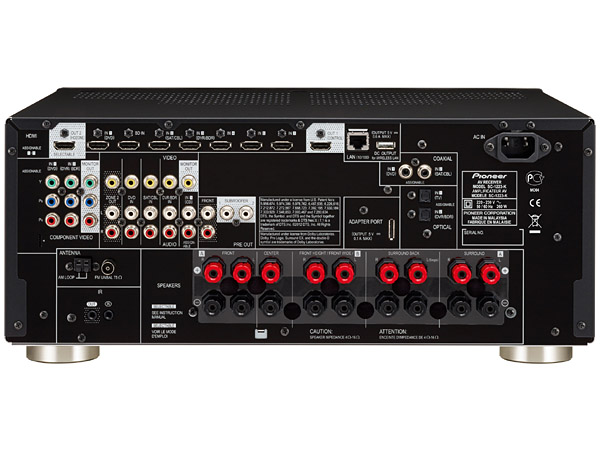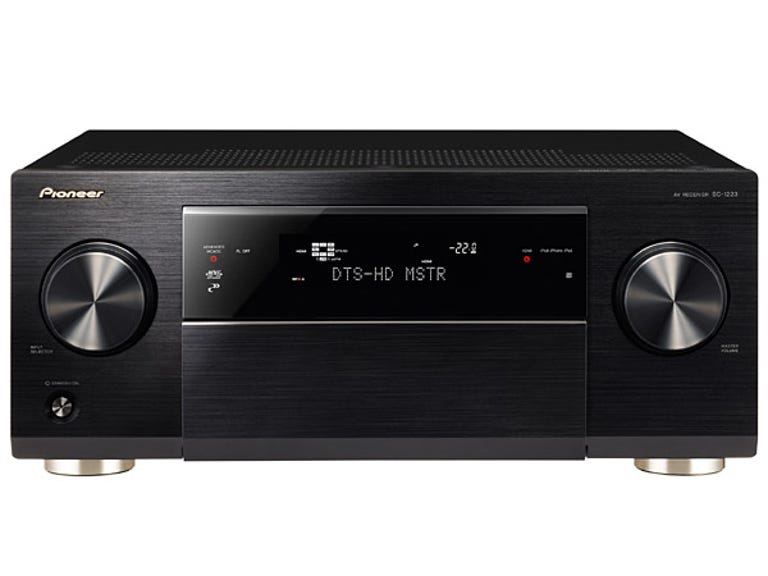 Why You Can Trust CNET
Why You Can Trust CNET Pioneer SC-1223 Home Theatre Receiver review: Pioneer SC-1223
The Pioneer SC-1223 offers near high-end audio and network performance and true high-end video performance all in a mid-priced unit.
Elsewhere we've looked at Pioneer's entry-level networkable home-theatre receiver, the VSX-528. This one, the SC-1223, is a little more than double the cost, at AU$1,499. Double that price again and you reach the top model in Pioneer's range.
The Good
The Bad
The Bottom Line
It's clear that even though there are many family similarities, the present receiver is very much closer to the top model than the entry-level one.
For one thing, it uses Class D amplifiers, which can be thought of as digital amplifiers or switching amplifiers. The output transistors are either fully on or fully off (except for the brief instances of switching between states), avoiding the relatively low efficiency states of being partially on or off. The result is much higher efficiency — typically 40 per cent higher than regular amplifiers — with the reduced heat dissipation allowing smaller heat sinks.
Pioneer rates this receiver's amplifiers at 100 watts output into 8 ohms at extremely low distortion levels, 160 watts into 6 ohms at 1 per cent distortion and 200 watts into 4 ohms also at 1 per cent. Into 8 ohms with all seven amplifiers running simultaneously, the receiver is good for 560 watts total, which comes to 80 watts per channel.
Importantly, the amps fully support 4-ohm loudspeakers, so you're pretty free to use whichever loudspeakers you like.
Two of the amplifiers can be set to different functions: surround back, front height, front wide, Zone 2 or a second pair of front stereo speakers. There are eight HDMI inputs (the one on the front supports MHL) and two HDMI outputs. The second one can be set for providing a different program to a second zone or to drive an extra monitor in the main zone. A proprietary adaptor port is available for use with Pioneer's optional Bluetooth dongle. If you want Wi-Fi, Pioneer has an adaptor (AU$149) that plugs into the Ethernet port and derives its power from a USB-like power socket on the back of the receiver.
Set-up
I'm generally just a touch more careful wiring Class D amplifiers than conventional ones since many have both the red and black speaker terminals electrically isolated from the chassis and earth of the unit. Most conventional home-theatre receivers have the black terminals earthed to the chassis. This receiver has things in reverse: it is the red terminal that is earthed. It should make no difference in practice, but it is a slight peculiarity.
Regardless, set-up was smooth, except (as so often happens) that during the automatic loudspeaker calibration, the receiver decided my centre and surround speakers were Large. They are good but do best without the very deepest bass in them. This receiver gives you options. One allows you to do a full calibration without adjusting the speaker sizes, so I redid it with Large preset for the front stereo speakers and "Small" for the others, so the receiver did its measurements on that basis. One limitation, though, is that the same crossover frequency to the subwoofer is applied for all the "Small" speakers, so those with unusual combinations of speakers may find it a little inflexible.
The HDMI 2 output is set to Zone operation by default. To change it, you have to go deep into the menus to switch that function. Once that's done, you can select output for HDMI 1, HDMI 2 or both (or neither). But HDMI 2 will not show the unit's on-screen display. Neither, it turns out, does HDMI 2 support the excellent video-processing functions provided by the receiver. So make sure your main display is connected to HDMI 1.

(Credit: Pioneer)
Sound and picture performance
There were two clear things about the audio performance of this receiver. First, whatever the specifications might indicate, it was immensely powerful, delivering effortless sound even with my large, low-impedance loudspeakers. Second, the EQ provided a strong, rich and detailed sound. But if you like things unprocessed, the Pure Direct audio mode switches off all that sound processing so that you can listen to stereo material to the highest quality level provided by your loudspeaker system.
If you're streaming audio, take a moment to hit the Audio Parameters key on the remote, arrow down to S.RTRV and switch this off. This is a circuit that claims to retrieve missing content from lossy compressed files. Aside from being impossible, it tends to make the sound a bit harsher as it invents non-existent content. It did quite a bit of damage to the sound of my MP3 tracks but made no apparent difference to high-resolution lossless audio (even though the menus indicated that it was switched on by default), suggesting that it's smart in operation.
The video performance (remember, HDMI 1 only for processing) was excellent. It has the ability to upscale to 4K, which isn't something I'd recommend. But I would recommend using its 1080p output capability, especially with signals from a DVD/Blu-ray player and a digital TV receiver. If possible, set those devices to output the native resolution (576i50 for DVD and SDTV, 1080i50 for some Australian Blu-ray discs and HDTV). Then let the receiver upscale. For most movies, you should turn on Pure Cinema and enjoy perfect progressive scan conversion, delivering the best detail. Otherwise, just leave it on Auto.
Smart stuff
The unit is controllable by Pioneer's iOS and Android iControlAV apps. This does not just replicate the normal remote but adds lots of interesting features in a rich graphical environment. It's also useful for dialling relatively quickly through lists of artists and albums and such on DLNA servers. But it's not as good as some: it doesn't fully populate at the outset, so you have to hit an arrow every so often to add the next section of the list.
On the USB front, the receiver supports a wide range of audio files: MP3, WAV, WMA, AAC, Apple Lossless, FLAC, AIFF and, unusually, DSD. This last is Direct Stream Digital, the format used on Super Audio CDs. Only stereo is supported for all of these not multichannel. And for DSD, only the standard 2.8MHz version not the even rarer 5.6Mhz variety.
You can stream music to the receiver via Airplay and DLNA (including push style from portable devices, such as Samsung's AllShare). All those formats are supported via DLNA apart from DSD.
Internet radio is provided by vTuner, which offers a wide a range as is available anywhere. If you have a premium Spotify subscription, you can also use Spotify Connect, in which you use a control app on a portable device, but the receiver streams the music directly from the Spotify servers. Some of those functions that seemed a bit clunky on the cheaper Pioneer receiver worked smoothly here. Selecting the receiver from the list in the Spotify iOS app almost instantly switched the receiver over to that function. The Android Spotify app has now also been updated to support the Spotify Connect function.
Conclusion
For a mid-priced home-theatre receiver, the Pioneer SC-1223 is pretty impressive. I'd prefer it to have multiple subwoofer crossover frequencies, but aside from that, the audio performance could not be faulted. The video processing is excellent. The network and USB audio support is very strong, and the receiver is guaranteed to support even 4-ohm loudspeakers, which says a lot about its amplifiers
.

